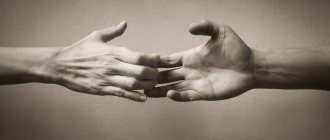When most people hear the word addiction, they think of dependence on substances such as drugs or alcohol. But alcohol, drugs and other commonly abused substances are not the only things people abuse. Or they think they might be addicted to them.
In fact, simply replace the word “substance” with the word “behavior” and you will discover the definition of behavioral addictions, some of which may surprise you. For example, this could be the Internet, shopping or skydiving. The desire to experience a “high” becomes so strong that the addicted person loses control and seeks activity, despite all the negative consequences.
And so, let's look at the most common habits that people get hooked on.
Gadget addiction
Science has provided humanity with innovative and technological mechanisms and gadgets that are part of every person's life today. From cell phones to high-tech televisions, from multimedia gaming systems to music players, it's a gadget that holds the world right in our pocket. People have now reached a point where they cannot live without these devices. This ultimately leads to dependence on them. This addiction has become a serious problem in the world, especially among teenagers.
Addiction to gadgets is determined by getting pleasure from using a laptop, tablet, smartphone, game console, etc., and spending a lot of time and other resources on it. Today it is difficult to imagine a modern teenager without a mobile phone or any other devices. Network, email, movies, games, music, Internet - all this is available in a few clicks.
Teenagers these days are becoming gadget-addicted, they do not participate in social activities, but “sit” on social networks, they do not go outside, to parks to play, but have game consoles and video games, they do not have “human friends.” “, but there are gadgets and most importantly, they do not have hobbies and hobbies, but there is an addiction that can cause a harmful lifestyle and affect their academic performance and quality of life.
Case from practice
Sergey, 25 years old, married, works as a taxi driver. He was a good racing athlete. His passion is driving at high speeds, for which he was constantly fined and his license was taken away, but he continued to exceed the speed limit. Sergei realized the problem and wanted to solve it.
To do this, his true needs were clarified, the illusion of fulfillment of which was created by adrenaline mania, and alternative ways were found to satisfy these needs; The trigger mechanism that includes such a behavior program has been studied, and several trainings have been conducted.
The passion for speed remained (he was the first in training at the car club and at competitions, and did not miss Formula 1 television broadcasts), but the “racing” on city streets stopped.
Shopping addiction (shopaholism)
Whether it's shopping with friends on the weekend, picking out new clothes for work or trinkets for a friend, spending holidays on gifts under the tree—shopping can even be called someone's job. It's normal to give in to the occasional impulse purchase. After all, most people love to shop. However, for some, shopping is much more than a pleasant pastime, and in some cases it is a real and destructive addiction that can turn into a disaster.
Overspending and forced purchasing can be defined as inappropriate, excessive and uncontrollable. Impulsivity is a key feature, basically lack of control over your impulses leads to damage.
Shopping addiction can wreak havoc on a person's life, family, relationships, physical and mental health, and finances. Buying in excess can get out of control and lead to more serious problems that detract from, rather than enhance, your quality of life. The more you use shopping as an attempt to fill an inner emptiness or pain, manage your feelings, restore your mood, or strive for an “ideal” image, the more likely it is that you need to take a closer look at the cost of these behaviors.
Sometimes you start using shopping as a defense mechanism against your negative emotions or feelings. You may temporarily escape your problems, but at the end of the day they are still there. Timely seeking qualified help, such as psychological counseling and cognitive behavioral therapy, will help you overcome the craving for thoughtless, impulsive purchases.
What is heroin
Diacetylmorphine (or heroin) is a semi-synthetic drug. Included in the group of opiates. Until the beginning of the twentieth century, it was widely used for medical purposes. Until doctors noticed that the drug causes a pathological addiction. Heroin is a drug with a high addictive potential. A few doses are enough to form a stable pathological craving.
The drug is synthesized in laboratory conditions and the bulk of it is opium poppy alkaloids. In its pure form, the drug looks like a white powder. But in underground laboratories various toxic impurities are added to the crystals. Therefore, this mixture takes on different shades.
Chemical formula – C21H23NO5.
The precursor for the synthesis of heroin is morphine. After obtaining acetate or diacetylmorphine salts, the purification step occurs. The output is almost 96% of the narcotic substance.
But clandestine laboratories do not have the necessary equipment. Raw materials for synthesis are often used of questionable quality. After its processing, the output is a mass with a low content of diacetylmorphine. The bulk are impurities that were formed during the reaction.
The artisanal drug causes severe adverse reactions. Death can occur with the first dose.
Slang names for drugs:
- White;
- Big foolishness;
- Gerych;
- Bread;
- Cartoon;
- Black caviar;
- Cag.
It is human nature to strive for pleasure. However, for many of them you have to pay a high price: loss of health, family, social circle, personality degradation, and legal liability.
Drug addiction is a national disaster. E. I. Mayorova.
Eating disorder (food addiction)
Food addiction is a disease similar to drug or alcohol addiction in which a chemical reaction in the brain is triggered by a particular behavior. In food addiction, the behavior that triggers the reaction is eating a certain food or a certain amount of food. This addiction manifests itself as an uncontrollable craving for excessive eating and usually involves eating salty, sweet or carbohydrate-rich foods to satisfy an increased appetite.
Eating disorders can lead to complications in the functioning of internal organs (gastrointestinal tract, endocrine and nervous systems) and are difficult to treat. In severe cases, according to doctors, getting rid of food addiction can be more difficult and longer than overcoming drug addiction or alcoholism. People suffering from alcohol addiction, for example, can stop drinking alcohol under artificial conditions (isolation in a rehabilitation center, taking medications incompatible with alcohol, etc.).
Such long-term isolation makes it possible to overcome addiction. But people who are addicted to food still need to eat. There can be no talk of any isolation. Only in specialized clinics is it possible to recreate conditions where, with the help of trained staff, food will be taken on a limited basis.
Help for the victim
Diacetylmorphine is considered a hard drug. Timely provision of first aid can save the life of the victim.
Actions:
- Call an ambulance;
- Lay the victim on a hard surface, turn his head to one side - to prevent aspiration of vomit;
- Don't let me sleep;
- Provide a flow of fresh air, remove tight clothing;
- Monitor pulse and breathing - if not, begin resuscitation measures;
- Rinse the stomach (if administered orally) if the victim is conscious.
Medical care consists of supporting the indicators of vital organs and systems. The patient is given an antidote – an opioid antagonist. According to indications, symptomatic therapy is carried out. The victim is taken to the toxic intensive care unit. Without complete detoxification, it is impossible to avoid serious complications.
Without medical help, the prognosis is rarely good. The victim falls into a coma. Death occurs from acute cardiac or renal failure.
Addiction to risky behavior (adrenaline addiction)
Adrenaline junkie is a term used to describe people who enjoy intense and exciting activities that produce an adrenaline rush. This is the type of person who likes things like skydiving, extreme sports or potentially dangerous activities such as roofing, hooking, etc.
When you are excited, fearful, or emotionally overstimulated, your body releases the hormone adrenaline. When this hormone enters the bloodstream, it increases your heart rate, blood pressure, and breathing rate, which can heighten your senses and give you an energy boost.
Unfortunately, thrill seekers are now not only adults, but also teenagers. To show their “coolness” and satisfy their desires, teenagers are ready to do a lot. They often openly play with death, which doctors note in such individuals is a decrease in self-preservation instincts.
Every year in Russia there are accidents that end in disability or, in the worst case, death for those who want a thrill. Unfortunately, this does not stop adrenaline fans, and they are ready to come up with new ways to get extreme risky sensations: driving at high speed, riding electric trains, clinging to handrails, jumping from roofs, descending into the mines of abandoned buildings, etc.
How to calm it down?
- Treatment, as in other types of addictions, begins with recognition and awareness of the problem. Because until you understand that the problem exists, no one and nothing can help you. The most important thing is the willingness of the person himself to do something about it. Re-read carefully what consequences your hobby can lead to, and think about whether you are ready to sacrifice your health and relationships with loved ones in order to satisfy the need for euphoria?
- Look for other ways to boost your self-esteem. Read my article that I already mentioned. Explore other areas where you can feel successful and have fun.
- Play sports. Not risky, but for example, running, working out in the gym, yoga, swimming... In fact, while performing any physical exercise, adrenaline and endorphins are produced. Only if you are passionate about regular sports are they not only safer for your health, but also more beneficial. And by the way, it also helps to raise self-esteem when you manage to complete the planned program in the number of approaches during exercises with dumbbells, or run as many kilometers as you couldn’t manage in previous times.
- It is quite possible to abandon your passion for extreme sports, just control the level of risk. And so that it is not in first place in the value system. For example, if it is racing, then not in the city, creating an emergency situation, but on special tracks, if skiing, without descents along “black slopes” and without complex acrobatic performances.
- Communicate more. This is a very important moment for healing, you need to learn to enjoy communication with other people, from contact with them on an emotional level, from the creation or renewal of close relationships.
Love and sex (sex addiction)
Sex addiction, also often called hypersexuality and compulsive sexual behavior disorder, is a condition in which the sufferer becomes overly preoccupied with thoughts or behaviors that produce the desired sexual effect.
For some people, sex addiction can be very dangerous and lead to significant difficulties in relationships. Like drug or alcohol addiction, it can have a negative impact on a person's physical and mental health, personal relationships, quality of life, and safety.
Plastic surgery addiction
The desire to achieve the “highest” standard of beauty becomes contagious among us. For celebrities who are often caught on camera, enhancing their beauty is commonplace and becomes "normal". But plastic surgery can also attract non-showbiz people to the process of improving their appearance.
Addiction to plastic surgery can be classified as a behavioral addiction.
People who are attracted to both non-surgical and surgical procedures are obsessive about certain behaviors. These types of people are mainly concerned with correcting that part of their body that they consider to be faulty and/or ugly. By correcting some of their perceived shortcomings, a person can feel comfort and satisfaction. In most cases, these sensations do not last, but only stimulate the patient’s interest in repeated plastic surgery. One operation to improve beauty does not immediately lead to addiction.
Like the risk of substance abuse, the danger of excessive attraction to beauty can lead to permanent depression. These effects can lead to difficulties in a person's personal life. In addition to the possible dangers to mental health, plastic surgery can also affect a person's physical health. Excessive plastic surgery can cause permanent damage to muscles and skin.
Classification of benzodiazepines
Drugs in this class are divided into several groups:
It is important to note that benzodiazepines should only be taken as prescribed by a doctor and the recommended dosage should be strictly followed. It has also been scientifically proven that the effectiveness of benzodiazepines decreases with long-term use. If the drug is not replaced, tolerance appears. As the dose increases, there is a high risk of addiction, as in the case of Jordan Peterson, whom we wrote about above. Doctors do not recommend using these drugs for long-term treatment due to addiction and severe consequences, incl. withdrawal symptoms You should also not prescribe the course and dosage of benzodiazepines on your own. All this should be done by a doctor after a complete diagnosis.











